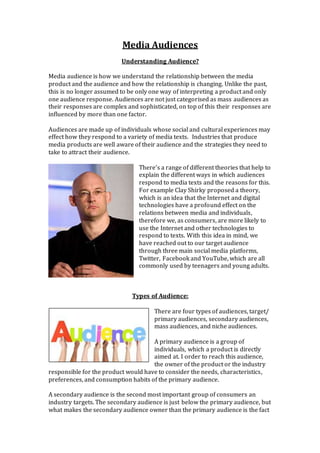
Media audiences
- 1. Media Audiences Understanding Audience? Media audience is how we understand the relationship between the media product and the audience and how the relationship is changing. Unlike the past, this is no longer assumed to be only one way of interpreting a product and only one audience response. Audiences are not just categorised as mass audiences as their responses are complex and sophisticated, on top of this their responses are influenced by more than one factor. Audiences are made up of individuals whose social and cultural experiences may effect how they respond to a variety of media texts. Industries that produce media products are well aware of their audience and the strategies they need to take to attract their audience. There’s a range of different theories that help to explain the different ways in which audiences respond to media texts and the reasons for this. For example Clay Shirky proposed a theory, which is an idea that the Internet and digital technologies have a profound effect on the relations between media and individuals, therefore we, as consumers, are more likely to use the Internet and other technologies to respond to texts. With this idea in mind, we have reached out to our target audience through three main social media platforms, Twitter, Facebook and YouTube, which are all commonly used by teenagers and young adults. Types of Audience: There are four types of audiences, target/ primary audiences, secondary audiences, mass audiences, and niche audiences. A primary audience is a group of individuals, which a product is directly aimed at. I order to reach this audience, the owner of the product or the industry responsible for the product would have to consider the needs, characteristics, preferences, and consumption habits of the primary audience. A secondary audience is the second most important group of consumers an industry targets. The secondary audience is just below the primary audience, but what makes the secondary audience owner than the primary audience is the fact
- 2. that this audience has fewer demands and might have less money to spend on your product. A mass audience, sometimes known as a broadcast audience, consists of people who frequently consume popular/ mainstream products or texts. A niche audience is smaller audience, which consists of a selected group of people with a unique. Out of all of these types of audiences, our product is aimed towards a mass audience as the genre, which is drama, appeals to a large amount of people. Not only this but our short film also deals with a topic, which is relevant and mainstream, which will appeal to a larger audience. Audience categories: Demographic profiling – this is a statistical way of gathering information on populations. We were able to use this type of data to gather information about different age groups and how to target them. Having age categories helps companies and institutions to target the right age group to market their product to. In our production we choose people within the age category of 12-30, therefore we were able to find specific ways to target our chosen audience. Another form of demographics is class and occupation; this is a way for us to target our audience according to their professional status and income. The social status demographics is divided into social grades which are A (upper middle class), B (middle class), C1 (lower middle class), C2 (skilled working class), D (working Class), and E (those at the lowest level of income). Based on this information, we chose to base our target audience on people who belonged to the D, C1, and C2 social grade because we wanted to target people who would have more time on their hands to watch our film, and also because our actresses mostly belong to these categories so our audience can familiarise themselves with our actresses easily.
- 3. Another type of demographic is gender. Even though our production only features females, we still decided to target both male and females. The main reason for this decision was due to the fact that in the UK (2014) there were 450 male cases for cancer compared to 310 cases for females, which shows that cancer affects males as much as females. Therefore having this as the main subject of our plot makes it appealing to males too. Audience response: Different types of audience will respond to our product in different ways depending on category they fall under. One type of audience is an active/ interactive audience, these people find themselves being actively involved in making sense of the message provided by a given product, and applying it to their social and personal lives. Maslow’s hierarchy of needs is a theory he proposed stating that human have five needs, which include: self-actualisation (self-fulfilment needs), esteem needs and belongingness and love needs (which are both categorised as psychological needs), safety needs and physiological needs (which are both basic needs). This theory suggests that an active audience fall into the category of self-actualisation as these people often find themselves being involved with a product.
- 4. Another type of audience response is from a passive audience which is the opposite of an active audience. This audience consists of people who do not engage much with a media product and simply just accepts whatever the deeper message of the media product is. Katz and Lazafeld (1995) proposed a hypodermic needle theory which states that the message conveyed in a product represents a bullet, which is fired from the media (representing a gun) before it goes into a viewer’s head. This theory suggests that messages are ‘injected’ into a passive audience before the message is wholly received and accepted.